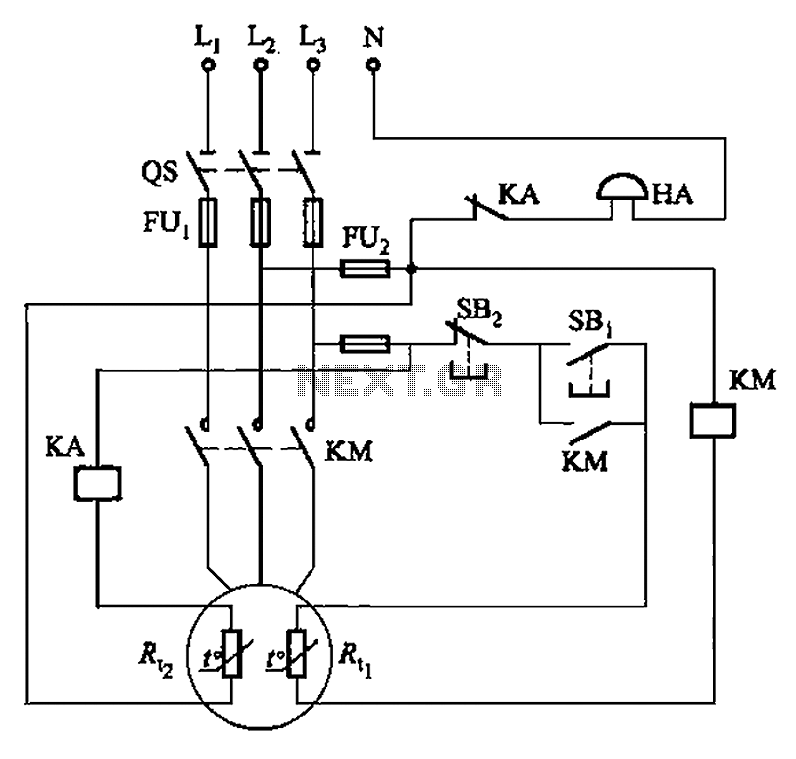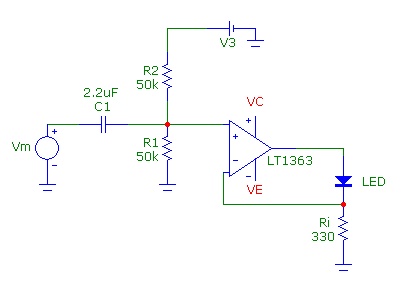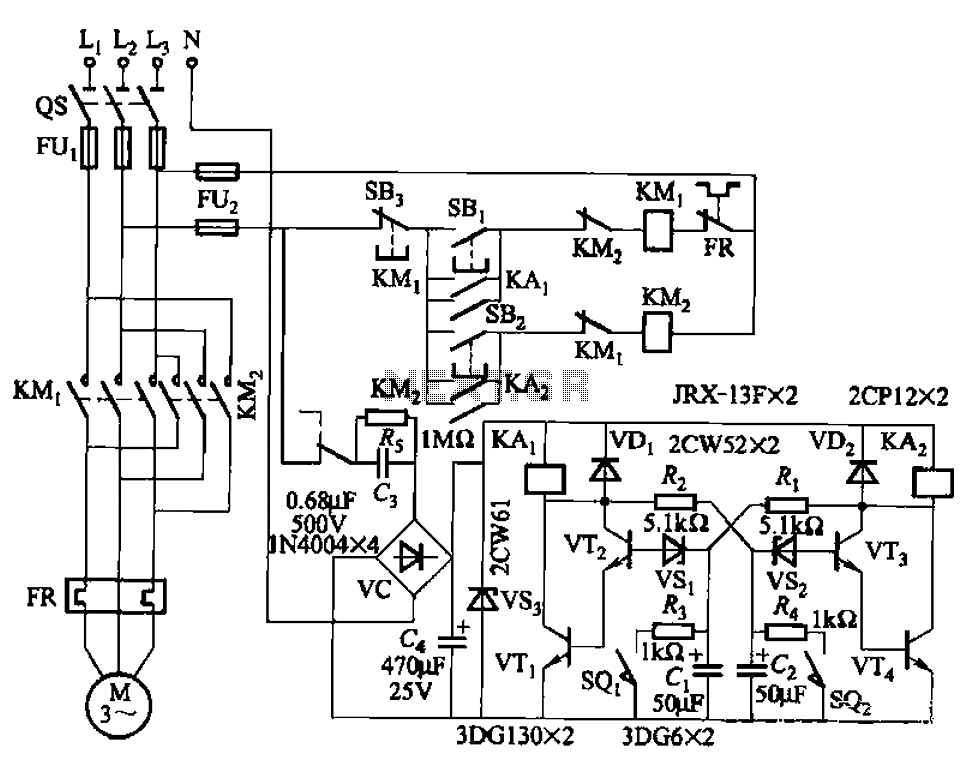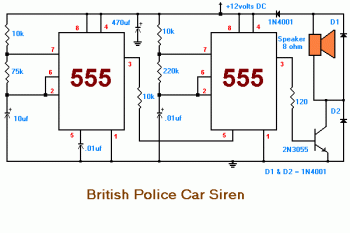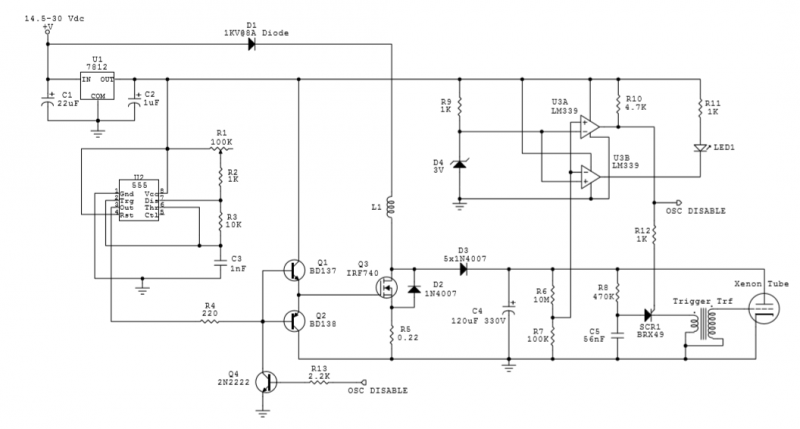
Single-chip audio power amplifier circuit
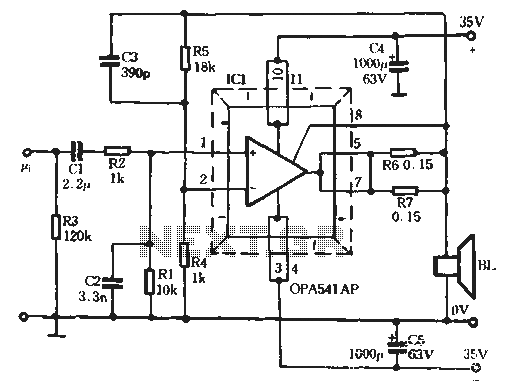
The Burr-Brown OPA541 chip is a power amplifier capable of operating with a maximum power supply voltage of 40V, delivering a continuous output current of up to 5A. The output current can be adjusted using an external resistor to protect both the amplifier and the load, ensuring normal operation. The OPA541 is available in two package types: one with plastic leads and another in a 3 TO sealed package. It is recognized for its superior performance as a power amplifier. The circuit, as illustrated in Figure 5-106, operates with an input audio signal level of 1.3V and, when supplied with a symmetrical ±35V power supply, can drive a load of approximately 60 to 80W. The output current is limited by parallel resistors R6 and R7, which can handle a maximum current of 8.5A, thereby providing safe operation for driving loads up to 4 ohms and achieving maximum driving power. The resistors R6 and R7 are configured to ensure safety and provide short circuit protection, with a current threshold set at 1.8A. The current threshold resistor Rc can be calculated using the formula: Rci = (0.813 / Laha) - 0.02 (N). The amplifier exhibits low distortion, with total harmonic distortion (THD) less than 0.5%, and a quiescent current of only 20mA. The bandwidth is determined by capacitor C3, approximately 22kHz, while the input filter composed of R2 and C2 reduces intermodulation distortion (IMD) and bandwidth, resulting in an actual bandwidth of 16.6kHz. The low-end cutoff frequency is determined by R1 and C1, which results in a cutoff frequency of 6.6Hz.
The OPA541 power amplifier is designed to deliver high efficiency and low distortion for audio applications. With a maximum supply voltage of 40V, it can effectively amplify audio signals while maintaining fidelity. The continuous output current capability of 5A makes it suitable for driving various loads, including speakers with low impedance. The external resistors R6 and R7 play a crucial role in current limiting, ensuring that the amplifier operates within safe parameters to prevent damage from overcurrent conditions.
The circuit configuration allows for flexibility in adjusting the output current, enhancing the protection of the load and the amplifier itself. The calculated current threshold resistor Rc is essential for fine-tuning the performance of the amplifier, allowing for customization according to specific application requirements. The low total harmonic distortion (THD) of less than 0.5% indicates that the amplifier can reproduce audio signals with high accuracy, making it ideal for high-fidelity audio applications.
The bandwidth specifications, defined by the components C3, R2, and C2, ensure that the amplifier can effectively handle a wide range of audio frequencies, while the low-end cutoff frequency established by R1 and C1 ensures that low-frequency signals are adequately amplified without significant attenuation. This design allows the OPA541 to excel in various audio amplification scenarios, providing robust performance and reliability.Burr-Brown OPA541 chip is produced by a power amplifier, which can by a maximum of 40V power supply electricity to produce the maximum continuous output current of 5A. Via an external resistor, adjust the size of the output current to protect the discharge amplifier and the load, so that the normal work © OPA541 has two packages, one is plastic ß feet, the other is a 3 TO sealed package. OPA541 is a better performance of the power amplifier. Circuit shown in Figure 5-106, the circuit in the input audio signal level value of 1. 3V; which, when the symmetrical earth 35v power supply, it is possible to provide a load of about 80 to 60W mouth this time, through parallel resistance R6, R7 limits the output current value (max 8.
5A), but also safe driving 4n of the load, and thus obtain the maximum driving power. However, R 6 and R7 set the amplifier to be taken to ensure safety to give short circuit protection make the amplifier 6 in its area of work safety, it requires current threshold is 1. 8A. Determine current threshold resistor Rc, can be calculated following formula: Rci = (0.813 / Laha) -0.02 (N) low-distortion of the amplifier, THD less than 0.5% O lC quiescent current of only ZOmA, bandwidth used by C3 decision, approximately 22kHz, the input filter R2, C2 for reducing IMD (intermodulation distortion internal), and reduce the bandwidth, the actual bandwidth reduced 16.
6kHz; low end cutoff frequency of the R 1, C 1 decides for 6. 6Hz. / P SE "). Change (function () {J SRPPShunt Regulated Push Pull cSRPP " f" o c 6F2 " beta " SRPP " f " b " beta " R6, R7 m 2-10 b cSRPP Two Pass J F3mA " beta " I, o F2.5mAc
The OPA541 power amplifier is designed to deliver high efficiency and low distortion for audio applications. With a maximum supply voltage of 40V, it can effectively amplify audio signals while maintaining fidelity. The continuous output current capability of 5A makes it suitable for driving various loads, including speakers with low impedance. The external resistors R6 and R7 play a crucial role in current limiting, ensuring that the amplifier operates within safe parameters to prevent damage from overcurrent conditions.
The circuit configuration allows for flexibility in adjusting the output current, enhancing the protection of the load and the amplifier itself. The calculated current threshold resistor Rc is essential for fine-tuning the performance of the amplifier, allowing for customization according to specific application requirements. The low total harmonic distortion (THD) of less than 0.5% indicates that the amplifier can reproduce audio signals with high accuracy, making it ideal for high-fidelity audio applications.
The bandwidth specifications, defined by the components C3, R2, and C2, ensure that the amplifier can effectively handle a wide range of audio frequencies, while the low-end cutoff frequency established by R1 and C1 ensures that low-frequency signals are adequately amplified without significant attenuation. This design allows the OPA541 to excel in various audio amplification scenarios, providing robust performance and reliability.Burr-Brown OPA541 chip is produced by a power amplifier, which can by a maximum of 40V power supply electricity to produce the maximum continuous output current of 5A. Via an external resistor, adjust the size of the output current to protect the discharge amplifier and the load, so that the normal work © OPA541 has two packages, one is plastic ß feet, the other is a 3 TO sealed package. OPA541 is a better performance of the power amplifier. Circuit shown in Figure 5-106, the circuit in the input audio signal level value of 1. 3V; which, when the symmetrical earth 35v power supply, it is possible to provide a load of about 80 to 60W mouth this time, through parallel resistance R6, R7 limits the output current value (max 8.
5A), but also safe driving 4n of the load, and thus obtain the maximum driving power. However, R 6 and R7 set the amplifier to be taken to ensure safety to give short circuit protection make the amplifier 6 in its area of work safety, it requires current threshold is 1. 8A. Determine current threshold resistor Rc, can be calculated following formula: Rci = (0.813 / Laha) -0.02 (N) low-distortion of the amplifier, THD less than 0.5% O lC quiescent current of only ZOmA, bandwidth used by C3 decision, approximately 22kHz, the input filter R2, C2 for reducing IMD (intermodulation distortion internal), and reduce the bandwidth, the actual bandwidth reduced 16.
6kHz; low end cutoff frequency of the R 1, C 1 decides for 6. 6Hz. / P SE "). Change (function () {J SRPPShunt Regulated Push Pull cSRPP " f" o c 6F2 " beta " SRPP " f " b " beta " R6, R7 m 2-10 b cSRPP Two Pass J F3mA " beta " I, o F2.5mAc
Warning: include(partials/cookie-banner.php): Failed to open stream: Permission denied in /var/www/html/nextgr/view-circuit.php on line 713
Warning: include(): Failed opening 'partials/cookie-banner.php' for inclusion (include_path='.:/usr/share/php') in /var/www/html/nextgr/view-circuit.php on line 713
